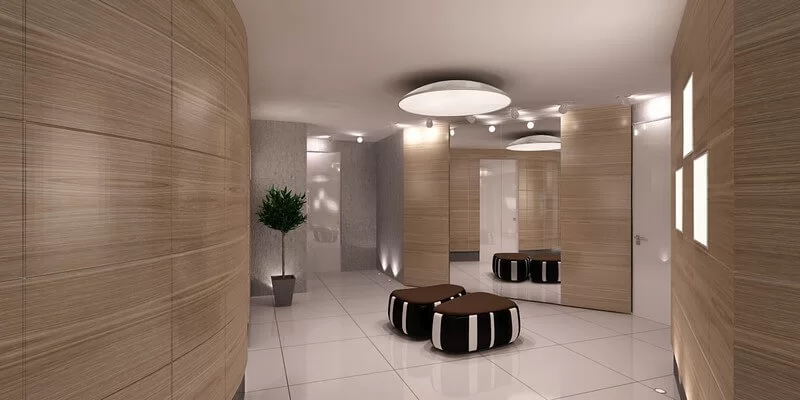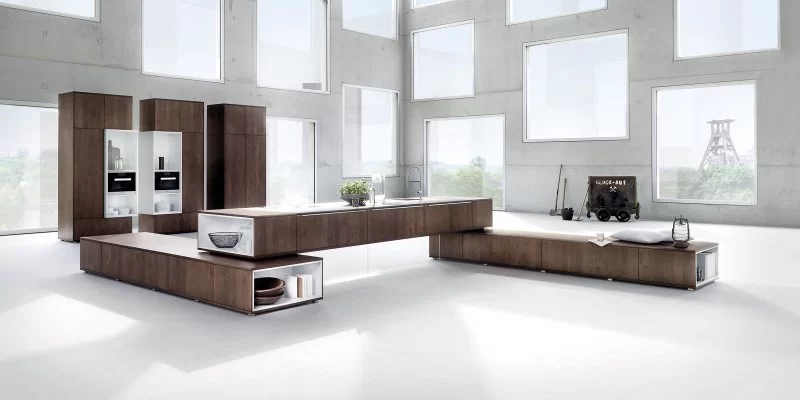A variety of modern finishing and construction materials leads to the fact that it can be very difficult to choose the right one. But you want furniture and interior elements to serve for a long time, to be practical and safe. Therefore, the choice of materials must be taken with all responsibility.
Among the materials of wood origin, veneer and MDF are now the most common. Of these, doors, interior partitions and cabinet furniture are made.
In this article, we will understand what is the difference between veneer and MDF — and which is better for use in certain conditions.
Veneer

Veneer is a woodworking product, the most environmentally friendly and beautiful. That is why it is often used as a finishing material. For example, veneered interior doors are widespread on the market, which visually practically do not differ from those made of solid wood.
The veneer is obtained from a log. A thin shaving is cut from it with a whole sheet. The log is fixed in a special machine, a knife is placed along it, and then the “source” begins to rotate. The knife cuts a thin wooden sheet, which is called veneer.
That is why the veneer retains the texture of wood and its natural shade. In the future, the sheets can be glued together — and then plywood is obtained. In addition, valuable wood veneer is used in furniture finishing — it can be covered with a “layer” of ebony, Karelian birch, rosewood, and so on.
In practice, veneer in its pure form is practically not used due to the small thickness of the sheet. It either turns into plywood, or they get off with decor and furniture items. From clean sheets of thick veneer, in rare cases, except that musical instruments are made.
As a result, “veneered” doors and furniture are either made of plywood or simply covered with this material.
On the other hand, veneer is environmentally friendly. Even in the form of plywood, it has no chemical compounds in contact with air (resins, adhesives, paints). Therefore, veneered furniture can be installed in the kitchen and in the children’s room. But for the bathroom, it is not suitable — the material is very sensitive to high humidity and under its influence can begin to collapse.
So, let’s sum up.
Advantages
-
Attractive appearance, completely preserving the texture of solid wood;
-
Environmentally friendly and safe, veneer does not emit harmful substances into the air;
-
It can be made of valuable wood species while maintaining their visual and practical qualities.
Flaws
-
Vulnerable to moisture
-
Does not participate in the process of air exchange (air-tight and vapor-tight);
-
Poor quality as a sound insulator;
-
Plywood is extremely unstable to mechanical shocks, easily breaks and cracks.
Since the veneer itself is practically not used in its pure form, when buying veneered furniture it is advisable to study what exactly is its basis and is used as a structural material — plywood, MDF, chipboard, fiberboard or other processed products.
MDF

MDF (Medium Density Fibreboard) is a wood processing product, which is a pressed chip. At the same time, the production technology is somewhat different. Some variants of MDF provide for “clean” pressing, without the addition of binders. In other cases, wood chips are mixed with urea resins.
The addition of carbamide resins not only increases the strength of MDF boards, but also allows you to give the material some important performance properties. For example, it can be flame retardant, water resistant, or resistant to biohazards (fungus, mold, pests).
The production method also affects the performance parameters. For example, untreated MDF has excellent air and vapor permeability. Therefore, interior doors made from it create a pleasant microclimate in the room and do not allow air to stagnate. However, their mechanical strength is extremely low. Yes, and this material is hygroscopic — it quickly absorbs moisture, turning into an excellent place for the development of fungi and mold.
The impregnated MDF, in which wood chips are held together with resin under pressure, is spared from the above disadvantages. It is strong, reliable and durable. Able to resist pests, fungus and mold. It is good to make furniture from impregnated MDF — it becomes stable and reliable. What’s more, the resin can make it water-resistant — and then the table or chair can even be used in the bathroom. And, of course, it increases the mechanical strength of the material.
On the other hand, impregnation deprives MDF of air and vapor permeability. Therefore, it is not recommended to use it as a material for interior doors. If the room is closed for a long time, the air in it will seem “stale”.
So, let’s sum up.
Advantages
-
Air and vapor permeability for unimpregnated;
-
High strength, reliability and excellent performance for impregnated;
-
Low price.
Flaws
-
Low mechanical strength and hygroscopic properties of unimpregnated;
-
Lack of air and vapor permeability in impregnated;
-
Ugly appearance.
It is worth noting that MDF in its pure form is practically not used (except in the production of containers and acoustic cases) — precisely because of its unattractive appearance. Even non-impregnated sheets are either laminated with polymer films that imitate the texture of wood or simply have some color, or are veneered.
Which is better — veneer or MDF?

So, veneer is sheets of natural wood that are used as a finishing material in combination with some kind of base (or are turned into plywood in further production), and MDF is chipboard, which is good to use as a structural material.
However, the difference between the two materials is not limited to this.
|
|
|
|
|
|
Cut (peeled) sheets of wood
|
Pressed sawdust with or without resin
|
|
|
Finishing or turning into plywood
|
Film lamination or veneering
|
|
|
Decorative purpose, plywood can be used to assemble structures
|
Manufacture of cabinet furniture, wall and structural panels, laminate, containers, acoustic enclosures
|
|
|
Medium
|
excellent
|
|
|
high
|
Impregnated impermeable, unimpregnated permeable
|
|
|
Low
|
Low for unimpregnated, high for MDF with resin
|
|
Resistance to biological harmful factors
|
Medium
|
Without impregnation, it is easily susceptible to mold
|
So, the ideal solution is MDF with veneer. It combines the advantages of both materials.

Добавить комментарий
Для отправки комментария вам необходимо авторизоваться.